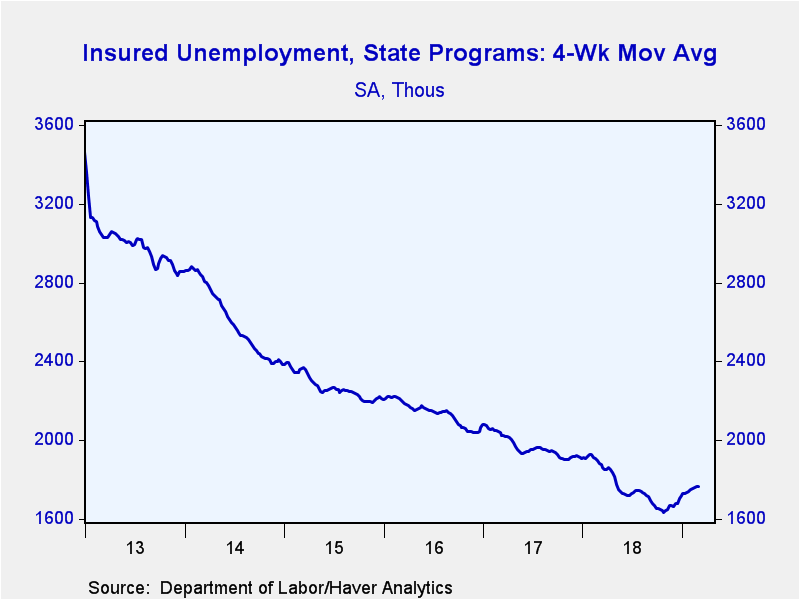 Global| Mar 14 2019
Global| Mar 14 2019U.S. Initial Unemployment Insurance Claims Rise
Summary
Initial claims for unemployment insurance rose 6,000 in the week ended March 9 to 229,000 from 223,000 the week before, which was unrevised. The Action Economics Forecast Survey projected 225,000 claims for this week. The four-week [...]
Initial claims for unemployment insurance rose 6,000 in the week ended March 9 to 229,000 from 223,000 the week before, which was unrevised. The Action Economics Forecast Survey projected 225,000 claims for this week. The four-week moving average of initial claims edged down to 223,750 from 226,250 the previous week.
Continuing claims for unemployment insurance increased slightly in the week ended March 2 to 1.776 million from 1.758 million the previous week. That previous week's number was revised up from 1.755 million. The four-week moving average in the March 2nd week was 1.766 million, a slight downtick from 1.767 million the week before.
The insured unemployment rate – that is, continuing claims as a percentage of the measure of employment covered in the unemployment insurance programs – was again 1.2% in the March 2 week.
In the separate program for federal government workers, 814 of them filed for unemployment insurance in the March 2nd week, up from 658 the prior period. This count now seems well established back in its "normal" range after the inflated numbers during the federal government shutdown in late December and through January.
Insured unemployment rates vary widely by state. These state data are not seasonally adjusted and are reported with a two-week lag to the headline claims figure. In the week ending February 23, the lowest rates were in Florida (0.43%), North Carolina (0.49%), Georgia (0.62%), Tennessee (0.62%), Virginia (0.62%) and Arizona (0.69%). The highest rates were in Alaska (3.05%), New Jersey (2.82%), Rhode Island (2.80%), Montana (2.64%), and Connecticut (2.60%). Rates in other states with large populations include California (2.24%), Texas (0.97%), New York (1.94%), Pennsylvania (2.32%) and Illinois (2.20%).
Data on weekly unemployment claims going back to 1967 are contained in Haver's WEEKLY database and are summarized monthly in USECON. Data for individual states are REGIONW. The expectations figure is from the Action Economics Forecast Survey, carried in the AS1REPNA database.
| Unemployment Insurance (SA, 000s) | 03/09/19 | 03/02/19 | 02/23/19 | Y/Y % | 2018 | 2017 | 2016 |
|---|---|---|---|---|---|---|---|
| Initial Claims | 229 | 223 | 226 | 1.9 | 221 | 244 | 262 |
| Continuing Claims | -- | 1,776 | 1,758 | -4.9 | 1,766 | 1,967 | 2,135 |
| Insured Unemployment Rate (%) | -- | 1.2 | 1.2 |
1.3 |
1.2 | 1.4 | 1.6 |
Carol Stone, CBE
AuthorMore in Author Profile »Carol Stone, CBE came to Haver Analytics in 2003 following more than 35 years as a financial market economist at major Wall Street financial institutions, most especially Merrill Lynch and Nomura Securities. She has broad experience in analysis and forecasting of flow-of-funds accounts, the federal budget and Federal Reserve operations. At Nomura Securites, among other duties, she developed various indicator forecasting tools and edited a daily global publication produced in London and New York for readers in Tokyo. At Haver Analytics, Carol is a member of the Research Department, aiding database managers with research and documentation efforts, as well as posting commentary on select economic reports. In addition, she conducts Ways-of-the-World, a blog on economic issues for an Episcopal-Church-affiliated website, The Geranium Farm. During her career, Carol served as an officer of the Money Marketeers and the Downtown Economists Club. She has a PhD from NYU's Stern School of Business. She lives in Brooklyn, New York, and has a weekend home on Long Island.









